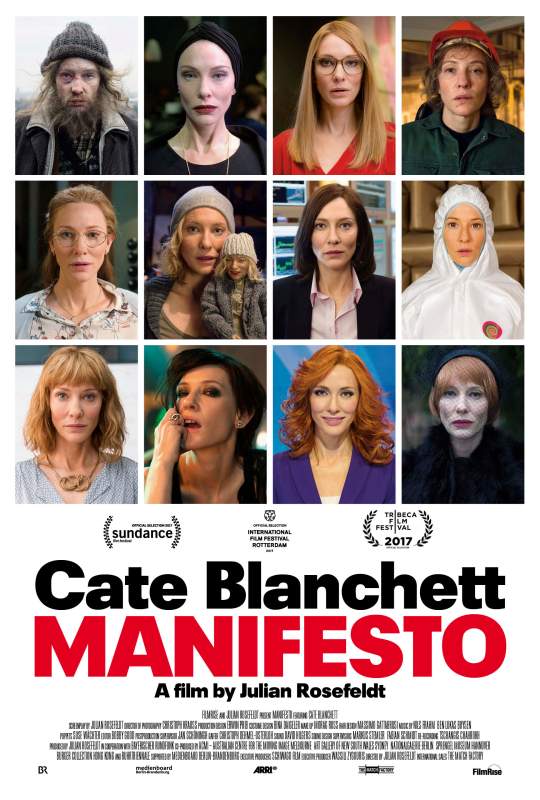Review: Manifesto Is a Cate Blanchett Acting Master Class, But Little Else


As an actor, Cate Blanchett can do no wrong. She’s usually the best part of anything she’s in (yes, even Indiana Jones and the Kingdom of the Crystal Skull. Yes, even with that over-the-top accent). She also generally makes really interesting choices. In addition to her illustrious film career, she was also the co-artistic director of the Sydney Theatre Company for five years, performing in and directing a wide variety of plays. Lately, she’s been in artsy, experimental mode with things like the Del Kathryn Barton film, RED, and now Julian Rosefeldt’s art film, Manifesto. One thing’s for sure: she’s not boring. I wish the same could be said for a good chunk of this film.
Here’s the official synopsis:
“From acclaimed visual artist Julian Rosefeldt, MANIFESTO features two-time Academy Award® winner Cate Blanchett in 13 distinct, must-see vignettes that incorporate timeless manifestos from 20th century art movements. From anchorwoman to homeless man, from Pop Art to Dogma 95, a chameleonic Blanchett gives a tour-de-force performance as she transforms herself like never before. Rosefeldt weaves together history’s most impassioned artistic statements in this stunning and contemporary call to action.”
Manifesto started life as an art installation, individual vignettes that were a part of an exhibition where 13 different characters (all played by Blanchett) were speaking the words of some of the world’s most important artistic manifestos. The vignettes were running separately and simultaneously, which may not have been the ideal way in which to experience the piece. One of the reasons why I wanted to see the feature-length film version was to see how well it held together as a single piece and to see if there was a thematic narrative going through the parts, adding up to a satisfactory whole.
The good news: there was! The bad news: I wouldn’t exactly call it entertaining, or even particularly enlightening.
The film definitely had its moments. For starters, Blanchett’s performances are exquisite to watch, and she does breathtaking character work here, making art manifestos sound like impromptu normal, human speech. Particularly successful are her turns as a woman speaking about Dadaism at a funeral:

…an CEO raising arts funding from a group of wealthy patrons and giving a thank-you speech in the form of the tenets of Vorticism, Blue Rider, and Abstract Expressionism:

…Blanchett as a punk musician railing against the world using the words of Stridentism and Creationism:

…a hilarious vignette that co-starred Blanchett’s real-life husband, Andrew Upton, and three boys I’m assuming were here actual sons, featuring Blanchett as a Conservative mother saying grace over dinner using a manifesto on Pop Art:

…and the final two vignettes: one in which Blanchett is a teacher filling a class of elementary school kids in on how to be great filmmakers (Dogma 95 is great for fifth graders!), and one in which a newscaster is quizzing a correspondent (both, again, played by Blanchett) on the meaning and purpose of art using the language of Conceptual Art and Minimalism.
So, that’s about half the vignettes that I’d consider worth watching, and they succeeded because they each individually captured the feeling of the actual art movements they were representing. What better and more pointed way to discuss Pop Art than to feature the most bland, mainstream American family? What better way to capture the “anti-art,” purposely offensive vibe of Dadaism than to have a really put-together woman railing and cursing at a funeral? In these successful segments, the message, characterization, and tone were all crystal clear. They were also vibrant, dynamic, and well-paced.
Then, there’s the other half of the film, in which Blanchett plays a homeless man, a choreographer, a broker, a worker in a garbage incineration plant, a scientist, and a puppeteer. In each of these segments, Rosefeldt felt the need to have really long, lingering shots of nothing, or Blanchett moving really slowly for no discernible reason. There was also the matter of these manifestos being the least clearly audible. Her homeless man, for example, while completely lived-in and real, couldn’t be understood. Her choreographer’s staccato broke up the speech into dance instructions which made any train of thought hard to follow. and her blue collar worker and scientist were just such bland characters that, while they were successful portrayals of average people, they weren’t compelling enough to entice a viewer to listen to their narration or follow their slow death marches to work.
To enjoy, or at least get anything out of Manifesto at all, you need to have a high tolerance for artsy-fartsy pretentiousness, which I happen to have, mostly because I’m more fascinated by any artists’ need to express themselves in this way than I am in the piece itself. In fact, the manifestos at the end on Conceptual Art and Minimalism by Sol LeWitt, Sturtevant, and Adrian Piper speak to this. That the success of the piece is less important than the idea of the piece. If the idea is cool, then the piece has already succeeded, even if the work itself falls flat.
How appropriate, then, that this is the manifesto on which this film chooses to end, as that’s exactly what ends up happening. It’s an interesting idea to try and capture the history of art manifestos using nothing but a brilliant actress’ performances and the language of film. The execution was wonky more often than not, and in those moments I found myself checking my phone for the time a lot. But then there were moments where I was intrigued and entertained by what was going on onscreen. There were fewer of those moments, but they did exist.
So, was this film successful? Who the fuck knows? Art is pointless anyway.
Manifesto is NOW PLAYING at the Film Forum in New York City, at the Landmark Nuart in Los Angeles, and The Screen in Santa Fe. It will continue to screen at art house theaters throughout the summer. You can check out the full schedule here.
(images: FilmRise)
Want more stories like this? Become a subscriber and support the site!
—The Mary Sue has a strict comment policy that forbids, but is not limited to, personal insults toward anyone, hate speech, and trolling.—
Have a tip we should know? [email protected]